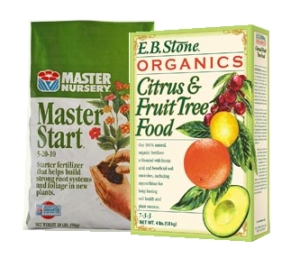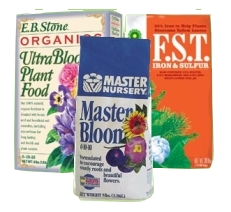Maintaining Your Fruit Trees

Fruit trees are a great addition to any yard and can provide a lot of satisfaction as you harvest fresh fruit from your garden. Fruit trees in general like to be grown in a sunny location. The information below will hopefully help you to be successful with growing healthy and productive fruit trees. The recommendations below are based on our Northern California climate and soil conditions. For other areas, timing and fertilizing schedules may vary. If you have any questions, please feel free to e-mail us.
FERTILIZING SCHEDULE
Spring - Fall

It is important to make sure your fruit trees have the nutrients they need, especially when young, to ensure the best possible fruit. We recommend fertilizing your fruit trees and fruiting vines as they emerge from dormancy. This is usually late February to March. We recommend using Master Start (5-20-10 with micronutrients) or the E.B. Stone Organics Citrus & Fruit Tree Food. These fertilizers will help with fruit production and root development without encouraging too much growth. If you are trying to encourage additional growth, then use a fertilizer that contains a higher level of nitrogen, like the Master Nursery Fruit Tree & Vine Food. Fertilize a second time in late spring to early summer after the fruit has set with Master Start (usually May or early June). Fertilize once again in late summer to early fall to encourage new fruit wood for next year. A higher nitrogen fertilizer, like the Master Nursery Fruit Tree & Vine Food can be used at this time, especially if you need to stimulate more fruit wood.
Winter

Starting in late October to early November begin fertilizing your fruit trees and fruiting vines with Master Bloom(0-10-10) and F.S.T.(iron, sulfur, manganese, and zinc). These two products should be applied approximately 3 times during the winter. By applying these fertilizers during the winter months, you are helping build up the necessary nutrients that your trees and vines will need in the Spring as they emerge from dormancy so that they can flower and fruit well.
Fertilizing Tip: When applying fertilizer, it is best to water lightly first before applying the fertilizer, and then water immediately afterward to prevent damage to your fruit trees.
PRUNING
There are different methods and
philosphies about when and how to prune. For most homeowners, you will want to
read and watch the video about Backyard Orchard Culture . This article discusses the newer techniques for keeping your
trees smaller and more manageable. This requires late spring and late summer
pruning, instead of winter pruning. This type of pruning is ideal for those who
want to be able to pick their fruit without the use of ladders.
If you
prefer traditional pruning methods, then prune while the trees are
dormant(usually Dec - Jan.). This method is used primarily for those who want
lots of fruit for canning or other purposes and don't mind taller trees. A good
book about traditional pruning of fruit trees is "How to Prune Fruit Trees".
This book talks about almost most fruit trees and fruiting vines. We usually
have it available at the nursery.
WATERING
Newly planted fruit trees should generally be watered once a week during the growing season(Spring - Fall). They may require more frequent watering during very hot periods or if planted in the summer months. Fruit trees being grown in containers will need more frequent watering. For more information about growing fruit trees in containers, visit our Growing Fruit Trees in Containers Page. If you are using a drip system, then make sure water is covering the entire root area. This usually requires 2 or 3 drippers to be placed around the tree or the use of a bubbler style dripper. Watering in the winter months, when the tree is dormant, is only required when there has been extended periods of no rainfall. As fruit trees become older and more established, less frequent watering is required, about every 10 to 14 days. However, they may need to receive additional watering during hot summer days or sudden heat waves.
DISEASE AND INSECT CONTROL
Most fruit trees will require some form of disease or insect control each year. Preventing potential problems is easier and more effective than treating after the fact. Dormant spraying (December - February) can greatly reduce fungal diseases and bug infestations that show up in the Spring. We recommend using a combination of Liqui-Cop (copper based fungicide) and Master Nursery Pest Fighter Oil during the dormant period to cover most issues. Apples, Pears, Asian Pears, and Cherries may require additional treatments for other bug problems. Please inquire with us regarding what is best for your trees specific needs.